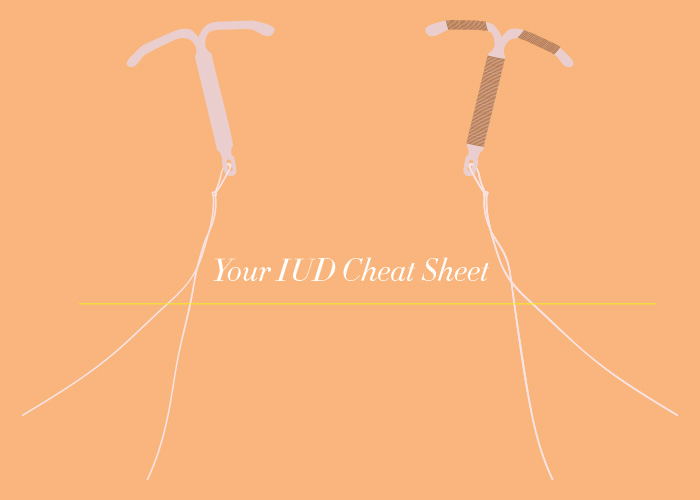 Getting an IUD can feel a little like winning the lottery.
Getting an IUD can feel a little like winning the lottery.
Money arrives one day and suddenly a major source of daily anxiety vanishes, giving you the freedom to go out and enjoy your life and stop freaking out about bills - er, babies.
Turns out, the interest and use of the convenient form of birth control is rising quickly among American women, for good reason.”It’s probably the most effective form of non-permanent birth control,” says Mireille Truong, MD, an OBGYN at NewYork-Presbyterian/Columbia in New York City.
In fact, modern IUDs are close to 100 percent effective at preventing pregnancy, with less than a one percent rate of failure, compared to nine percent (!) for oral contraceptives. And they’re a great option for busy women with iPhone pill alarms that never seem to go off when they’re listening, or for those who’d rather not introduce additional hormones (particularly estrogen) into their bodies.
Is any form of birth control perfect? “No, they all have their pros and cons, and everybody has to make the decision that’s right for them in the context of their lives,” says functional medicine physician and Parsley Health founder Robin Berzin, MD, who regularly recommends IUDs to her patients.
In case you’re in the process of making said decision, we asked the experts to walk us through some need-to-know facts, with plenty of my own I’ve-seriously-been-there thoughts on what having an IUD is really like.
Here are 9 things you need to know before getting an IUD:
1. It looks like an anchor and acts like a sperm shield. An IUD is generally shaped like the letter T or resembles a small anchor, and your doctor inserts it into your uterus during a quick procedure at the office. Tiny strings attached to the bottom hang down around your cervix, so you (or your doctor) can feel for them to make sure it’s still in place. It works by inhibiting the movement of sperm, stopping them before they get to the eggs to make fertilization happen. If your cycle was a soccer game, the IUD would be a really skilled goalie.

2. It will hurt, but not for long. Getting it placed is generally uncomfortable and comes with serious cramping. It's generally not too terrible, but others have reported awful pain. “It varies from person to person based on pain tolerance. And for people who have not had children, it’s generally more uncomfortable,” explains Dr. Truong, who recommends taking an Aleve or Motrin before and after the procedure.
3. You’ll have to choose from a few different kinds. IUDs are generally divided into two camps, a copper model that uses no hormones (ParaGard), and those that are plastic and release a low dose of progestin (synthetic progesterone) locally, in the uterus. Mirena, Skyla, and Liletta are all versions of that model. One major difference is the length of time the IUDs last for—10 years for ParaGard, five for Mirena, and three for Skyla and Liletta. “You can take it out sooner,” explains Dr. Berzin, “that’s just how long it will be effective.” Some other things to consider between the options are…

4. You could never get your period (after an initial rough patch).The hormonal IUDs thin the lining of your uterus off the bat, so the first few weeks or months can be rough for some women, with heavy bleeding and cramping or at least irregular spotting. Some experience a heavy period and some pretty gnarly pain for a full month. But after that, you’ll most likely have years of barely any bleeding to look forward to. “Up to 20 percent of women will have no periods at all,” Dr. Truong explains. If you do get it, it will be likely be much lighter than it was before.
5. Or it could get worse. With the copper version, “sometimes people can get heavier bleeding, but their periods will still be regular,” she says, so you may want to skip this one if that’s already an issue for you.

6. You don’t need to freak out about infections. For a long time doctors told women that IUDs increased the risk of infections in a big way, specifically Pelvic Inflammatory Disease (PID). While Dr. Truong and Dr. Berzin both say that the risk may potentially be raised ever so slightly for a very small window of time after the insertion procedure, a recent review of the scientific research on the subject found that overall, “the best evidence suggests that the risk of PID among IUD users is very low.”
7. And the other potential complications are very rare (but still scary sounding).“Most of the complications that happen are at the time, or surrounding the time, of placement,” Dr. Truong says. It could poke a hole in your uterus, for example, which sounds horrifying but normally heals on its own. And bigger, scarier-sounding complications like the IUD migrating to somewhere else in your body (check those strings!) or ectopic pregnancy are extremely rare, too.

8. You’ll still be able to get pregnant later on. Should you decide it’s time to start making babies, you can have an IUD removed at any time, and most women are able to get pregnant right away, especially with the copper, non-hormonal one. “[For] some people it can take up to six months on the hormonal [IUDs],” Dr. Truong says. “It depends on your body; it’s going to change the way your hormones regulate and react.”
9. IUDs are the most popular form of birth control among doctors.“It’s actually the option that most female doctors I know use,” says Dr. Berzin. “Everyone in medicine has an IUD.” Surveys have also supported her observation, and that’s not a bad endorsement, right?
~ Thanks to Lisa Elaine Held
No comments:
Post a Comment